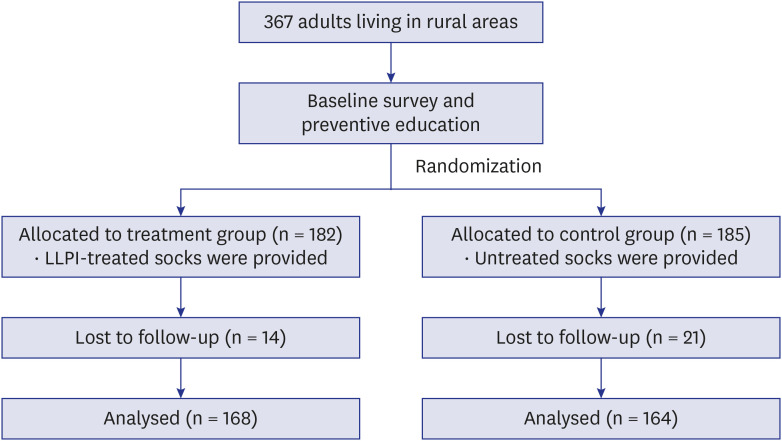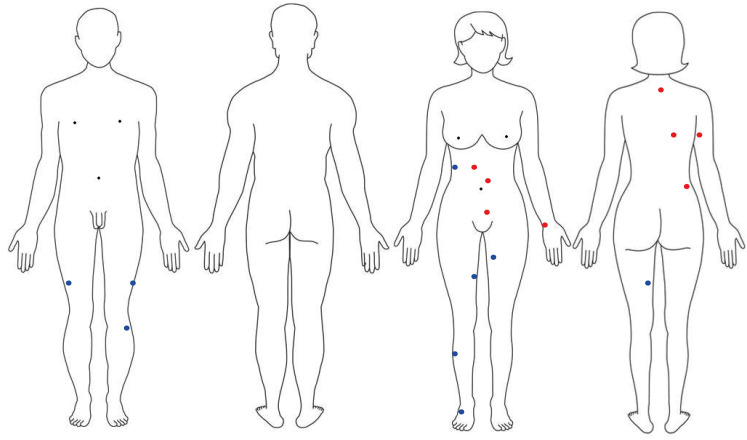J Korean Med Sci.
2021 Feb;36(7):e49. 10.3346/jkms.2021.36.e49.
The Effect of Long-lasting Permethrin Impregnated Socks on Tick Bite in Korea
- Affiliations
-
- 1Department of Preventive Medicine, College of Medicine, Chosun University, Gwangju, Korea
- 2Premedical Science, College of Medicine, Chosun University, Gwangju, Korea
- 3Department of Internal Medicine, Chosun University Hospital, Gwangju, Korea
- 4Department of Clinical Pathology, Seoyeong University, Gwangju, Korea
- KMID: 2513073
- DOI: http://doi.org/10.3346/jkms.2021.36.e49
Abstract
- Background
The risk of tick-borne diseases is decreased by increasing awareness and knowledge through prevention education. The aim of the present study was to evaluate the effect of long-lasting permethrin impregnated (LLPI) socks for tick bites.
Methods
A randomized open label study was conducted to determine the effectiveness of LLPI socks for prevention of tick bites among 367 adults living in a rural area. Participants completed questionnaires at the start of follow-up (July 2014) and at the end of follow-up (December 2014), and tick bites were reported.
Results
A total of 332 subjects completed the follow-up survey. The tick bite rate of the two groups was not significantly different (3.6% vs. 3.1%). But the tick bite rate of lower extremities of subjects wearing LLPI socks was significantly lower compared to that of subjects wearing general socks.
Conclusion
The tick bite rate was not different between the two groups, but the tick bite rate of lower extremities of LLPI was significantly lower than general groups. Further study is needed to investigate the effect of LLPI clothes with larger populations.
Figure
Reference
-
1. Park S, Cho E. National infectious diseases surveillance data of South Korea. Epidemiol Health. 2014; 36:e2014030. PMID: 25420951.
Article2. Dantas-Torres F, Chomel BB, Otranto D. Ticks and tick-borne diseases: a One Health perspective. Trends Parasitol. 2012; 28(10):437–446. PMID: 22902521.
Article3. Benelli G, Pavela R, Canale A, Mehlhorn H. Tick repellents and acaricides of botanical origin: a green roadmap to control tick-borne diseases? Parasitol Res. 2016; 115(7):2545–2560. PMID: 27146901.
Article4. Kim S, Kim JS, Lee H. Epidemiological characteristics of scrub typhus in Korea, 2009. Osong Public Health Res Perspect. 2010; 1(1):55–60. PMID: 24159441.
Article5. Piacentino JD, Schwartz BS. Occupational risk of Lyme disease: an epidemiological review. Occup Environ Med. 2002; 59(2):75–84. PMID: 11850549.
Article6. Occupational Safety and Health Administration. OSHA fact sheet: working outdoors in warm climates. Updated 2016. Accessed June 15, 2016. https://www.osha.gov/OshDoc/data_Hurricane_Facts/working_outdoors.html.7. Onyett H. Canadian Paediatric Society, Infectious Diseases and Immunization Committee. Preventing mosquito and tick bites: a Canadian update. Paediatr Child Health. 2014; 19(6):326–332. PMID: 25332663.8. Lane RS. Treatment of clothing with a permethrin spray for personal protection against the western black-legged tick, Ixodes pacificus (Acari: Ixodidae). Exp Appl Acarol. 1989; 6(4):343–352. PMID: 2743839.9. Evans SR, Korch GW Jr, Lawson MA. Comparative field evaluation of permethrin and deet-treated military uniforms for personal protection against ticks (Acari). J Med Entomol. 1990; 27(5):829–834. PMID: 2231620.10. DeRaedt Banks S, Orsborne J, Gezan SA, Kaur H, Wilder-Smith A, Lindsey SW, et al. Permethrin-treated clothing as protection against the dengue vector, aedes aegypti: extent and duration of protection. PLoS Negl Trop Dis. 2015; 9(10):e0004109. PMID: 26440967.
Article11. Banks SD, Murray N, Wilder-Smith A, Logan JG. Insecticide-treated clothes for the control of vector-borne diseases: a review on effectiveness and safety. Med Vet Entomol. 2014; 28(Suppl 1):14–25. PMID: 24912919.
Article12. Jones TF, Garman RL, LaFleur B, Stephan SJ, Schaffner W. Risk factors for tick exposure and suboptimal adherence to preventive recommendations. Am J Prev Med. 2002; 23(1):47–50. PMID: 12093423.
Article13. Wilder-Smith A, Byass P, Olanratmanee P, Maskhao P, Sringernyuang L, Logan JG, et al. The impact of insecticide-treated school uniforms on dengue infections in school-aged children: study protocol for a randomised controlled trial in Thailand. Trials. 2012; 13(1):212. PMID: 23153360.
Article14. Vaughn MF, Meshnick SR. Pilot study assessing the effectiveness of long-lasting permethrin-impregnated clothing for the prevention of tick bites. Vector Borne Zoonotic Dis. 2011; 11(7):869–875. PMID: 21395420.
Article15. Vaughn MF, Funkhouser SW, Lin FC, Fine J, Juliano JJ, Apperson CS, et al. Long-lasting permethrin impregnated uniforms: a randomized-controlled trial for tick bite prevention. Am J Prev Med. 2014; 46(5):473–480. PMID: 24745637.16. Faulde MK, Rutenfranz M, Keth A, Hepke J, Rogge M, Görner A. Pilot study assessing the effectiveness of factory-treated, long-lasting permethrin-impregnated clothing for the prevention of tick bites during occupational tick exposure in highly infested military training areas, Germany. Parasitol Res. 2015; 114(2):671–678. PMID: 25416331.
Article



